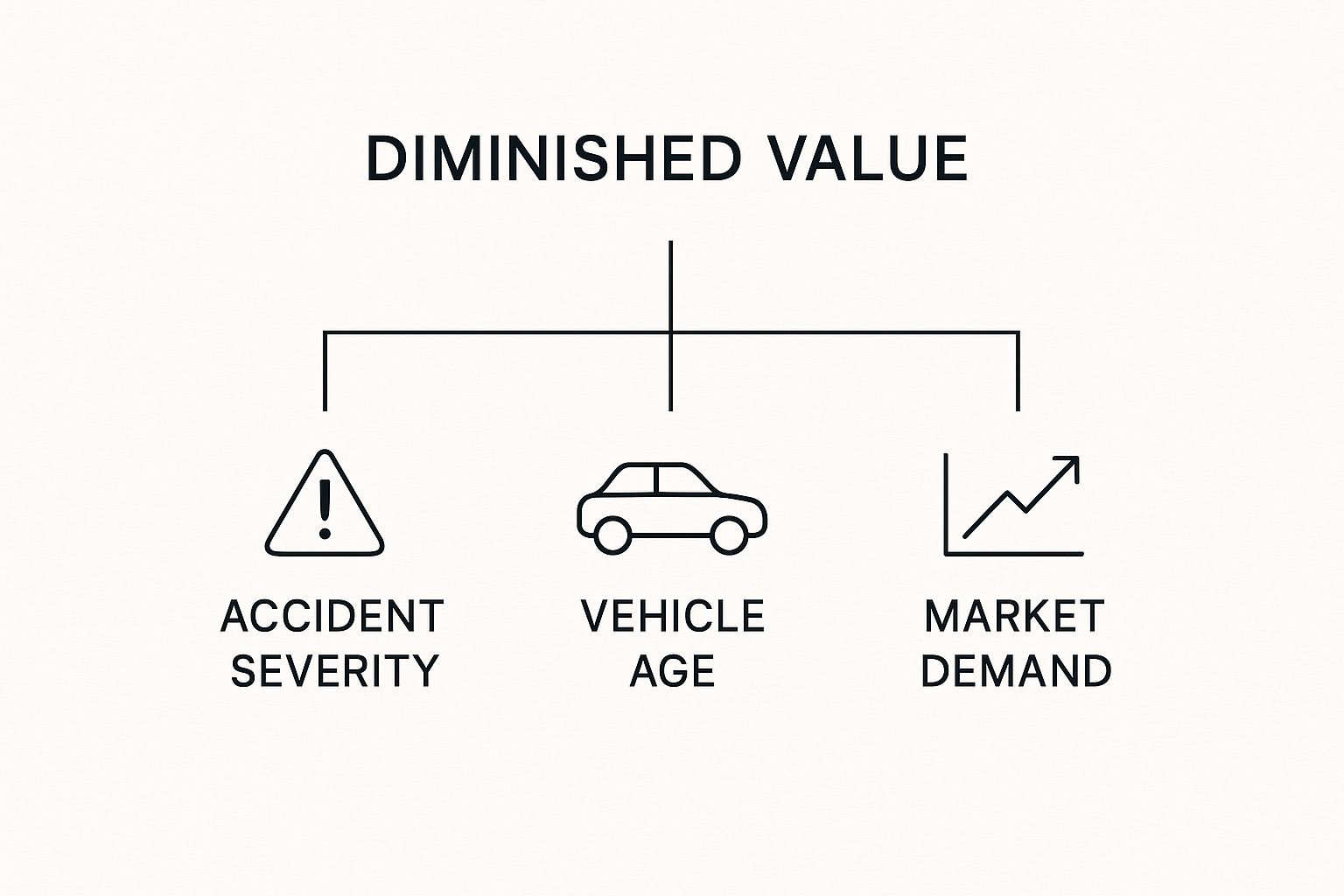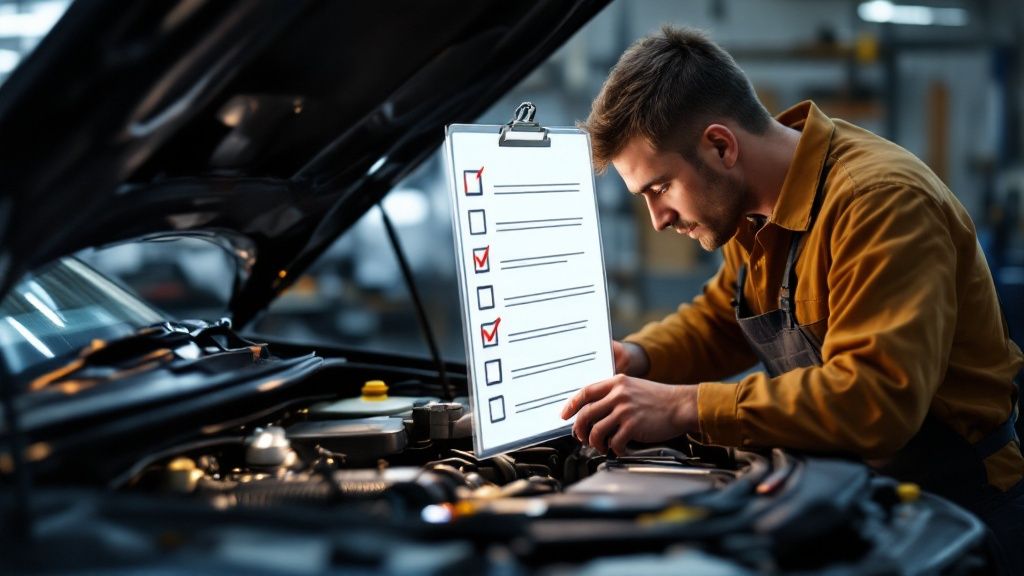Even after perfect repairs, a car involved in an accident carries a permanent stigma. This is the heart of diminished value: the unavoidable drop in your car’s resale price simply because it now has a collision on its record.
Think of it as a permanent financial scar. The physical damage gets fixed, but the history of the accident follows the car forever, making it less appealing to any future buyer.
The Hidden Cost of a Wreck

Let's imagine you're selling your car. An identical one—same make, model, year, and mileage—is for sale right down the street. The only catch? Yours has an accident on its vehicle history report, and the other one doesn't.
Which one do you think a smart buyer will choose? And if they do consider yours, they're definitely not paying the same price. That price gap is its diminished value.
The insurance company paid to fix the bent metal and broken glass, but they didn't compensate you for this hit to your car's market value. It's money you're owed, but you have to know to ask for it.
How an Accident Accelerates Depreciation
This loss is particularly frustrating because it piles on top of the normal depreciation that every car owner faces. Cars lose value the second they leave the lot, but a collision puts that process into overdrive.
A typical new car loses 16% of its value in the first year and another 12% in the second. After five years, it often holds only about 45% of its original sticker price.
Now, add an accident to the mix. A car that was worth $45,000 before a crash could instantly lose an extra 10% to 30% of its value. The exact amount depends on how bad the damage was and the desirability of your car's brand. You can dive deeper into how car depreciation works on thinkinsure.ca.
The Three Flavors of Diminished Value
While the concept seems straightforward, the insurance world slices diminished value into a few distinct types. Knowing the difference helps you build a stronger claim.
- Inherent Diminished Value: This is the big one. It's the automatic loss in value that happens the moment an accident is reported. Even with flawless, factory-quality repairs, the car is now officially "previously damaged," and buyers will pay less for it.
- Repair-Related Diminished Value: This comes into play when the repair job itself is subpar. Maybe the paint doesn't quite match, the shop used cheaper aftermarket parts instead of OEM ones, or a persistent rattle just won't go away. This is damage from the repair.
- Immediate Diminished Value: This is a more technical term for the loss in value right after the accident but before repairs are done. It’s rarely used in consumer claims.
For almost everyone filing a claim, the battle is over inherent diminished value. You're making the case that, through no fault of your own, your asset is now worth significantly less on the open market, and you deserve to be compensated for that loss.
Understanding the Three Types of Value Loss
When your car gets into an accident, its value doesn't just drop in one simple way. The loss is actually a bit more nuanced and can be broken down into three specific types. Figuring out which one—or which combination—applies to your situation is the first real step in getting the compensation you deserve.
Think of it like a doctor diagnosing an illness. You can't just say "I'm sick"; you need to know what the problem is to get the right treatment. The same goes for your car's value—you have to identify the specific kind of loss to build a strong claim.
Inherent Diminished Value: The Automatic Hit
This is the big one. Inherent Diminished Value is the immediate, unavoidable drop in your car’s market value simply because it now has an accident on its record.
Even if the best body shop in the country makes your car look brand new using only factory-original parts, the stigma is permanent. The moment that collision shows up on a vehicle history report from a service like CARFAX, its value takes a permanent hit. It's a fact of life in the used car market.
A smart buyer will always choose the car with a clean history over an identical one that's been in a wreck, or they'll demand a steep discount. That discount is the inherent diminished value, and you have a right to claim it.
Repair-Related Diminished Value: The Quality Factor
Next up is Repair-Related Diminished Value. This type of loss happens when the repairs themselves aren't up to snuff. It’s the extra value your car loses because the body shop did a shoddy job, compounding the financial damage from the accident itself.
You'll see this pop up in a few common ways:
- Mismatched Paint: The new paint is just a shade off from the original, making the repair obvious.
- Aftermarket Parts: The shop used cheaper, non-original parts instead of OEM (Original Equipment Manufacturer) components.
- Imperfect Gaps: The seams between body panels are uneven or too wide.
- Unresolved Mechanical Issues: Maybe there's a new rattle, a persistent alignment problem, or a weird noise that wasn't there before.
This isn't just about looks; it's about the real cost to get the job done right. This loss is an additional claim on top of the inherent value drop.
Immediate Diminished Value: The Pre-Repair Snapshot
Finally, there’s Immediate Diminished Value. This one is a bit more technical. It represents the loss in value right after the crash but before a single repair has been made. Think of it as the difference between your car's pre-accident value and what someone would pay for it in its wrecked state.
This type of value rarely comes up in standard insurance claims. It's really only relevant if you were to sell the damaged car "as-is" without ever fixing it.
For almost everyone reading this, the focus will be squarely on inherent diminished value. That’s where the real, lasting financial damage is, and it’s the number you’ll need an appraiser to help you prove.
The three types of diminished value each point to a different source of financial loss for a vehicle owner after an accident. Here's a quick breakdown to clarify the differences.
Types of Diminished Value Explained
| Type of Value Loss | Core Cause | Example Scenario |
|---|---|---|
| Inherent Diminished Value | The stigma of having an accident on its record. | Your perfectly repaired car is worth $2,000 less than an identical one just because its history report isn't clean. |
| Repair-Related Diminished Value | Poor-quality repairs that are visibly or mechanically flawed. | The body shop used cheap aftermarket parts, and the new bumper paint doesn't match the rest of the car. |
| Immediate Diminished Value | The physical damage to the car before any repairs are done. | Your car was worth $20,000 before the crash, but in its wrecked state, a salvage yard would only pay $5,000. |
Understanding these distinctions is key, as it helps you frame your argument and demand the right amount from the insurance company.

As you can see, factors like the severity of the damage, your car’s age and mileage, and even its popularity all play a role in determining how much value was actually lost.
How Is Diminished Value Actually Calculated?
So, how does an insurance company land on a specific number for your car's lost value? It’s not just a guess. Many insurers pull out a controversial, in-house formula known as "Rule 17c", which, surprise surprise, often spits out a number that works in their favor, not yours.
Getting a handle on how this formula works is the first step to understanding why it's so often wrong—and why you shouldn't just accept their initial offer.
Let's pull back the curtain on this process. At its core, the 17c formula is a multi-step calculation meant to quickly estimate your car's diminished value after an accident. It looks official, but its built-in limitations can cost you thousands.

Breaking Down the Rule 17c Formula
The calculation starts with your car's fair market value right before the crash. To find this, most insurers use a pricing guide like NADAguides (from the National Automobile Dealers Association). From that baseline number, they start chipping away at it with a series of caps and modifiers.
Let's walk through an example. Imagine you have a Honda CR-V that was worth $25,000 before the accident.
-
The 10% Cap: First, the insurance company applies a 10% ceiling to your car's pre-accident value. For our CR-V, that’s $25,000 x 10% = $2,500. Right off the bat, this becomes the absolute maximum they will consider for your diminished value, no matter how bad the damage really was.
-
The Damage Multiplier: Next, they apply a modifier based on damage severity. This is a bit of a gray area, but it generally follows a scale where minor cosmetic dings get a low score, while major structural damage gets the highest possible score.
-
The Mileage Multiplier: Finally, they apply another modifier based on your car's mileage. A vehicle with low mileage gets a higher score (since it held its value better), while one with high mileage gets a lower one.
The final offer is calculated by taking that capped value—$2,500 in our example—and then reducing it further using the damage and mileage multipliers. The result is almost always a disappointingly low number that doesn't come close to your car's actual loss in the open market.
Why the 17c Method Is So Flawed
The biggest problem with the 17c formula is that arbitrary 10% cap. There's no real-world, market-based justification for it. It's simply a limit created by insurers to control how much they have to pay out. A car with serious frame damage could easily lose 20% or 30% of its value, but this formula refuses to acknowledge that reality from the very beginning.
On top of that, the damage and mileage multipliers are highly subjective. It’s not hard for an adjuster to assign a slightly lower damage score to shave even more off the payout, leaving you with an offer that covers just a fraction of your vehicle's true loss. It's a system designed for the insurer's bottom line.
Better Ways to Determine Your Actual Loss
If Rule 17c is broken, how do you find the real number? The most accurate methods are grounded in actual market data, not made-up formulas.
-
Comparative Market Analysis: This approach is all about doing your homework. You find comparable vehicles for sale in your area and compare the asking prices of those with a clean history to those with a reported accident. The gap in price gives you a real-world snapshot of your diminished value. While it takes some digging, it provides solid proof. You can get a head start by using a reliable diminished value claim calculator that factors in these market dynamics.
-
Dealer Opinions: Give the sales managers at a few local dealerships a call. Ask them point-blank how an accident history like yours would impact your car's trade-in value. Getting this in writing can provide powerful supporting evidence for your claim.
-
Professional Appraisal: This is, by far, your most powerful tool. A certified, independent auto appraiser will perform a hands-on inspection of your vehicle and the quality of the repairs. They then conduct a detailed market analysis to produce a comprehensive report that quantifies your exact diminished value.
An independent appraisal isn't just an opinion—it's a meticulously documented expert report. This document becomes your number-one piece of evidence when you go back to the insurance company. It replaces their lowball 17c figure with a number grounded in reality, leveling the playing field and showing the adjuster you're serious about getting the compensation you deserve.
Key Factors That Impact Your Claim Amount
https://www.youtube.com/embed/0cqPPTc8zqI
When an insurance adjuster looks at your diminished value claim, they aren’t just glancing at the final repair bill. They're weighing a handful of specific factors to figure out how much your car's value has really dropped. If you know what they're looking for, you can build a much stronger case.
Think of it like putting together a puzzle. Each piece—from your car's age to the quality of the repair work—helps create the final picture of what your claim is worth. Knowing how those pieces fit gives you a serious advantage when it's time to negotiate.
Vehicle Age and Mileage
Let's start with an easy one: the newer your car and the lower its mileage, the bigger your diminished value claim will be. It's simple, really. A nearly new car with just a few thousand miles takes a massive financial hit from an accident. An older car with 150,000 miles? Not so much.
Buyers in the market for newer vehicles expect perfection and a clean history—and they pay for it. An accident record shatters that expectation. With an older, high-mileage car, a certain amount of wear and tear is already baked into the price, so a collision doesn't crater its value in the same way.
The Brand and Model of Your Car
Not all cars are created equal when it comes to post-accident depreciation. The make and model of your vehicle play a huge role in the amount of diminished car value after an accident. High-end and luxury vehicles usually get hit the hardest because their buyers are especially picky about condition and history.
For example, German luxury cars like BMW and Mercedes-Benz often see the steepest drops in value. On the other hand, a reliable workhorse like a Honda might lose much less, often around 10-20% initially. You can find more data on how different brands are affected at appraisalengine.com.
Severity of the Damage
This one is probably the most obvious, but it’s a biggie. There's a huge difference between a minor parking lot scuff and a collision that messes with the car's frame.
Adjusters look for key phrases in the repair estimate. A small cosmetic fix won't move the needle much. But if they see terms like "frame damage," "structural realignment," or "airbag deployment," the value loss jumps dramatically. Any repair that hints at a compromise to the vehicle's long-term safety or integrity will always lead to a higher diminished value payout.
Quality of Repairs and Parts Used
The quality of the body shop's work is another critical piece of the puzzle. A top-notch repair job using only Original Equipment Manufacturer (OEM) parts can help minimize your loss. But if the shop cuts corners with cheaper aftermarket parts or does sloppy work—think mismatched paint or panels that don't line up—that just gives the insurance company more reason to argue your car is worth less.
This is why you should always push for OEM parts and keep detailed records of every single repair. That paperwork is your proof of a quality restoration and a cornerstone of a successful claim. To see how the pros document this, you can learn more about getting a certified auto appraisal for diminished value.
The Vehicle's Prior History
Finally, what did your car's history look like before this accident? A car with a squeaky-clean record will have a much stronger diminished value claim than one that's already been in a wreck. The first accident causes the biggest drop; any subsequent accidents have a much smaller impact on its value.
And if your car already had a branded title (like "salvage" or "rebuilt")? Forget it. A diminished value claim becomes nearly impossible. The adjuster will simply argue that the car's value was already so compromised that this new damage barely made a difference.
Navigating State Laws and Insurance Policies

Getting paid for your car's diminished car value after accident isn't just a matter of proving the loss. It’s also about navigating a maze of state laws and insurance policy fine print. Where you live and who was at fault can completely change the game.
The first thing you need to get straight is the difference between a first-party and a third-party claim. This distinction is absolutely crucial because it almost always determines whether you can even file for diminished value in the first place.
First-Party vs. Third-Party Claims
Think of a first-party claim as one you file with your own insurance company. This is what you do when you’re the one at fault or when you use your own collision coverage to get your car fixed, regardless of who caused the accident.
Here's the bad news: most states won’t let you claim diminished value from your own insurer. The reasoning is that your policy is a contract to repair the vehicle to its pre-accident condition, not to restore its pre-accident market price.
A third-party claim, on the other hand, is when you file against the at-fault driver's insurance company. In this situation, their insurance is on the hook for the damages their client caused. This is where the door for a diminished value claim swings wide open. The other driver's insurer has a legal duty to "make you whole," which includes paying for the hit your car's resale value took.
Almost all successful diminished value claims are third-party claims. If the other driver was at fault, their insurance is responsible for covering your vehicle's depreciation.
State Rules and Time Limits
Your ability to successfully file a claim is heavily dependent on your state’s laws. While most states allow third-party diminished value claims, the specific rules and legal precedents can differ quite a bit. Some states are simply more consumer-friendly on this issue than others.
It’s essential to understand the rules where the accident happened, as this will shape your entire approach. For a deeper dive, our guide on state-specific diminished value laws breaks down this complex landscape.
You also have to watch the clock. Every state has a statute of limitations, which is a legal deadline for filing property damage claims. This window, usually two to three years from the date of the accident, is non-negotiable. If you miss it, you lose your right to pursue the claim forever.
Understanding Your Insurance Policy
Even when you're filing a third-party claim, it's a good idea to dust off your own policy and read it. Look for any language that mentions "depreciation," "actual cash value," or "market value."
While your policy probably won't pay for your diminished value, understanding its terms helps you grasp the bigger picture. Remember, cars already lose about 15-20% of their value each year through normal depreciation. An accident just pours gasoline on that fire. A luxury sedan, for example, might see its value plummet by 25-30% right after a serious collision, which shows you exactly how much money is on the line.
A Step-By-Step Guide to Filing Your Claim
Knowing your car has lost value is one thing; getting the at-fault driver's insurance company to pay for it is another. Filing a claim for the diminished car value after an accident takes a bit of strategy, but it’s a process you can absolutely handle. Think of this as your playbook for turning a collision into fair compensation.
You’re essentially building a case, just like a detective. Your mission is to present the insurance adjuster with such clear, undeniable proof of your loss that they have no choice but to offer a fair settlement. Every document, photo, and conversation is a critical piece of evidence.
Step 1: Assemble Your Documentation
Before you even pick up the phone to call the insurance company, get your paperwork in order. An organized file is your greatest asset here. Without solid documentation, your claim is just an opinion; with it, it becomes a fact-based demand for what you're owed.
Here’s the essential paperwork you'll need to gather:
- The Police Report: This is the official record that establishes who was at fault for the accident—a must-have for any third-party claim.
- Photos and Videos: Round up every image you have. You’ll want pictures of the accident scene, the initial damage to your car, and photos showing the completed repairs.
- Itemized Repair Invoice: This document is crucial. It breaks down every single part that was replaced and every hour of labor, proving just how extensive the damage really was. Check if it notes whether non-OEM (non-original) parts were used.
- Proof of Pre-Accident Value: You need to establish what your car was worth moments before the crash. Use trusted pricing guides like Kelley Blue Book or NADAguides to get a solid baseline value.
Step 2: Get an Independent Appraisal
This is, without a doubt, the most important step in the entire process. It’s the move that truly levels the playing field. The insurance company already has its own calculation ready, and you can bet it's a lowball offer. You need a powerful, expert-backed number to fight back.
Hiring a certified, independent auto appraiser is non-negotiable if you're serious about your claim. A true professional will physically inspect your vehicle, analyze the quality of the repairs, run a detailed market analysis, and produce a comprehensive report that quantifies your exact financial loss.
This report isn't just another estimate; it's professional-grade evidence. It takes your claim from a subjective "I think my car is worth less" to a data-driven argument that an adjuster can't simply ignore. This document will become the foundation of your entire negotiation.
Step 3: Write and Send a Demand Letter
With your appraisal report and all your supporting documents in hand, it's time to make your formal demand for payment. Your demand letter should be professional and straight to the point. Always send it via certified mail to the at-fault driver's insurance adjuster to create a paper trail.
Make sure your letter clearly states:
- Your name and contact information.
- The insurance claim number and the date of the accident.
- A straightforward statement that you are making a claim for the inherent diminished value of your vehicle.
- The specific dollar amount you are demanding, which should be the figure from your independent appraisal.
- A list of the documents you've enclosed (e.g., appraisal report, repair invoice, police report).
Sending this formal letter officially kicks off the negotiation and signals to the insurer that you're serious and prepared.
Step 4: Negotiate a Fair Settlement
Don't be surprised when the adjuster comes back with a low counteroffer, probably quoting some internal formula. This is standard procedure. The key is to stay calm, remain professional, and keep pointing back to your independent appraisal report.
Use that report as your anchor. Explain that your number is based on real-world market data and expert analysis, not an arbitrary, one-size-fits-all calculation.
If they refuse to budge, you can mention your next steps, such as filing a complaint with your state's Department of Insurance or pursuing the matter in small claims court. Often, just the possibility of having to deal with more hassle is enough to bring them to a more reasonable settlement. Remember, in this game, persistence pays off.
A Few Common Questions About Diminished Value
Even after laying out the whole process, a few questions always seem to pop up. Let's walk through some of the most common ones that people have when they're trying to claim diminished car value after an accident.
Getting clear on these points can make all the difference, giving you the confidence to see your claim through and get what you're owed.
Can I File a Claim If I Was at Fault?
This is the big one, and the answer is almost always no. Think of a diminished value claim as something you file against the person who caused the accident. It’s their insurance policy that covers the damage they did to your property—including the damage to its market value.
Your own policy is designed to cover the cost of repairs to get your car back into its pre-accident physical shape. It isn't set up to compensate you for the drop in resale value. So, if you caused the wreck, you generally can't file a diminished value claim with your own insurer.
Can I Claim Diminished Value After Repairs Are Done?
Yes, and that's actually the only way to do it. You have to wait until every last repair is finished before you can officially file. The whole point of the claim is to recover the inherent diminished value—the value your car lost simply because it now has an accident history, even with flawless repairs.
You can't prove how much value was lost until the repairs are complete. Only then can an appraiser see the quality of the work and calculate the final, lasting impact on your car's resale price.
How Long Does the Process Usually Take?
The timeline really depends on the situation, but you can generally expect a settlement within 30 to 90 days after you submit your demand letter and appraisal. If you have a solid, well-documented case and the insurance company is reasonable, things can move pretty quickly.
On the other hand, if the insurer digs in their heels or sends back a series of lowball offers, the back-and-forth can drag things out. This is where a professional, detailed appraisal report becomes your most valuable tool for keeping the process on track.
Do I Need to Hire a Lawyer?
For the vast majority of claims, you don't need a lawyer. The real power behind your claim isn't legal maneuvering; it's a rock-solid, certified independent appraisal report. This document is the expert proof that shows the insurance adjuster exactly how much value your car has lost.
An appraiser’s job is to establish the facts and put a number on your loss. A lawyer's job is to argue points of law. In property damage claims like these, the facts presented by an expert appraiser are what carry the most weight.
Now, if your claim is extremely high-value, incredibly complex, or you feel the insurance company is negotiating in bad faith, talking to an attorney is a smart move. But for most people, a professional appraiser is all you need to win a fair settlement.
If you're facing a lowball offer on a diminished value or total loss claim, don't accept less than you deserve. At Total Loss Northwest, our certified appraisers fight to get you a fair and accurate settlement based on real market data, not insurer formulas. We provide expert support in all 50 states to put real value back in your hands. Get a professional on your side by visiting us at https://totallossnw.com.





